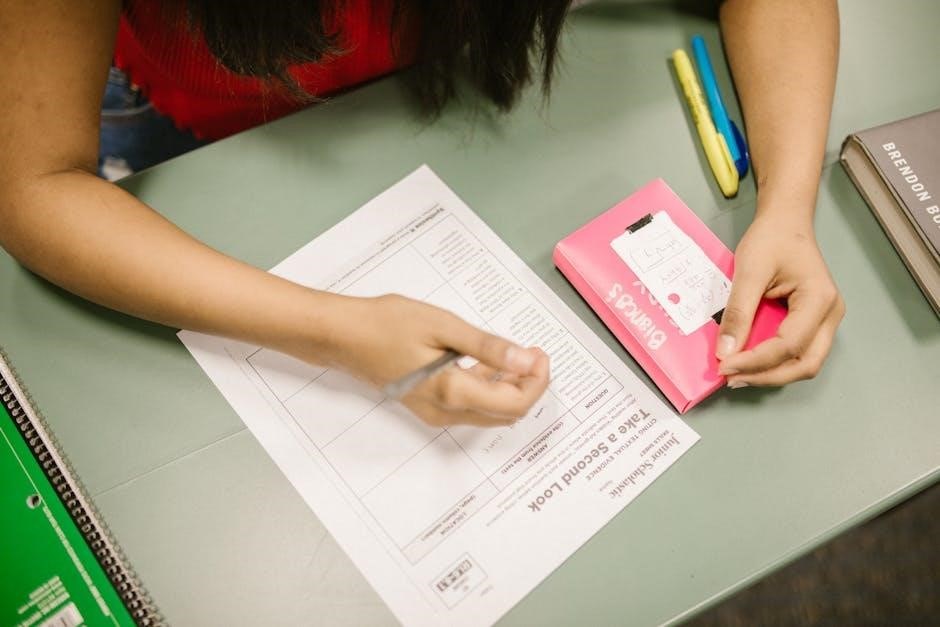The BKSB Initial Assessment evaluates English, maths, and ICT skills, aiding institutions in determining learners’ proficiency levels and guiding educational pathways effectively.
What is BKSB?
BKSB stands for Basic Key Skills Builder, a diagnostic tool used to assess English, maths, and ICT skills. It helps educational institutions evaluate learners’ proficiency levels, identifying strengths and areas needing improvement. The assessment is typically conducted online via the BKSB Live platform, providing detailed insights into individual skill levels. This tool is not a traditional test but a comprehensive evaluation to guide personalized learning plans. By pinpointing specific needs, BKSB supports tailored educational pathways, ensuring learners are placed in appropriate courses. Its primary goal is to enhance learning outcomes by addressing skill gaps effectively. Institutions widely use BKSB to create targeted interventions and monitor learner progress over time. This approach fosters a more structured and efficient learning environment.
Importance of the BKSB Initial Assessment
The BKSB Initial Assessment plays a crucial role in identifying learners’ skill levels in English, maths, and ICT, enabling educational institutions to tailor learning programs effectively. By pinpointing strengths and areas for improvement, it ensures learners are placed in appropriate courses. This assessment supports personalized learning plans, helping learners address specific gaps and progress at their own pace. It also aids in monitoring learner development over time, ensuring targeted interventions are implemented. The insights gained from BKSB are invaluable for creating structured learning pathways, fostering academic success, and enhancing employability skills. This tool is essential for aligning educational strategies with individual needs, promoting overall learner development and achievement.
Overview of the BKSB Initial Assessment English
The BKSB Initial Assessment English evaluates foundational language skills, focusing on reading, writing, and communication. It is designed to determine a learner’s current proficiency level, ensuring appropriate placement in educational programs. The assessment includes various question types, such as multiple-choice questions, gap fills, and essay writing, to comprehensively measure abilities. The results provide detailed insights into strengths and areas needing improvement, which are used to create personalized learning plans. This tool is widely used in educational institutions to streamline the learning process and ensure learners are well-prepared for further studies or employment. Its structured approach helps in setting clear academic goals and tracking progress effectively. The BKSB Initial Assessment English is a vital step in fostering skills development and academic success.

Structure of the BKSB Initial Assessment English
The BKSB Initial Assessment English is divided into sections covering reading, writing, and listening skills, with a mix of multiple-choice, gap-fill, and essay questions to assess proficiency effectively.
Sections Covered in the Assessment
The BKSB Initial Assessment English evaluates key areas of language proficiency, including reading comprehension, writing skills, and listening exercises. The reading section incorporates multiple-choice questions and gap-fill tasks to test vocabulary, grammar, and understanding of complex texts. Writing tasks may involve composing essays or emails, assessing fluency and accuracy. Listening exercises require learners to demonstrate comprehension of spoken English, such as identifying main ideas or specific details. These sections collectively provide a comprehensive overview of a learner’s English abilities, enabling tailored educational planning and resource allocation to address specific skill gaps effectively. This structured approach ensures learners are well-prepared for further education or employment.
Question Types and Formats
The BKSB Initial Assessment English features a variety of question types to evaluate different skills. Multiple-choice questions test vocabulary, grammar, and reading comprehension. Gap-fill tasks require learners to complete sentences or passages with appropriate words. Essay writing and email composition assess writing fluency and accuracy. Listening exercises involve identifying key details or main ideas from audio clips. True/false and matching questions are also included to reinforce understanding. These formats ensure a comprehensive evaluation of English proficiency, providing clear insights into strengths and areas for improvement. The mix of question types caters to diverse learning styles, making the assessment both engaging and effective for identifying skill levels accurately.
Time Allocation and Instructions
The BKSB Initial Assessment English typically has a time allocation of 60-90 minutes, depending on the institution. Learners are advised to carefully read instructions before starting. Each section, such as reading, writing, and listening, may have specific time limits. Instructions often include selecting one correct answer for multiple-choice questions or completing tasks like writing essays or emails. Learners are encouraged to manage their time effectively, ensuring they attempt all questions. Clear guidelines are provided for each task, and learners are reminded to review their answers if time permits. The assessment is adaptive, adjusting difficulty based on performance, ensuring accurate skill level identification. Properly following instructions is crucial for achieving accurate results.

Purpose and Benefits of the BKSB Initial Assessment
The BKSB Initial Assessment identifies learning needs, personalizes study plans, and enhances English proficiency, supporting learners in achieving their educational and career goals effectively.
Identifying Learning Needs
The BKSB Initial Assessment is designed to pinpoint areas where learners may need additional support in English. By evaluating skills such as reading comprehension, vocabulary, and writing abilities, the assessment provides a clear snapshot of a learner’s current proficiency level. This targeted approach helps educators and learners alike identify specific strengths and weaknesses, ensuring that learning resources can be tailored to address gaps in knowledge. The assessment also highlights areas where learners may require extra practice or review, making it an invaluable tool for creating personalized learning plans. This focus on individual needs ensures that learners receive the most relevant and effective support to improve their English skills.
Personalizing Learning Plans
The BKSB Initial Assessment plays a crucial role in personalizing learning plans by providing detailed insights into a learner’s abilities. Based on the assessment results, educators can tailor resources and activities to match individual needs, ensuring a focused approach to skill development. This personalized method allows learners to concentrate on areas where they need improvement while building on their strengths. The data from the assessment also enables the creation of actionable goals, making the learning process more structured and effective. By aligning learning strategies with the outcomes of the BKSB Initial Assessment, learners can progress at their own pace, fostering a more engaging and successful educational experience.
Improving English Proficiency
The BKSB Initial Assessment significantly contributes to improving English proficiency by identifying specific skill gaps and providing a clear foundation for progression. Learners gain insights into their strengths and weaknesses, enabling targeted practice in areas such as reading comprehension, writing, and vocabulary. The assessment results are used to create tailored learning resources, ensuring that each learner’s needs are addressed effectively. Regular practice with sample questions and resources helps build confidence and fluency, while tracking progress over time allows for continuous improvement. By focusing on individual growth, the BKSB Initial Assessment serves as a valuable tool for enhancing overall English skills and achieving educational goals.
How to Prepare for the BKSB Initial Assessment
Utilize official study materials, practice tests, and sample questions to build familiarity with the format and content. Focus on improving reading, writing, and comprehension skills through targeted revision strategies to ensure readiness for the assessment.
Official Study Materials and Resources
Official BKSB study materials provide comprehensive resources to help learners prepare effectively. These include detailed guides, practice tests, and sample questions that mirror the actual assessment format. Utilizing these resources ensures familiarity with the test structure, question types, and content. Additionally, learners can access online platforms and downloadable PDFs, such as the BKSB Initial Assessment English Answers PDF, which offer insights into correct answers and explanations. These tools are essential for identifying strengths and weaknesses, allowing learners to focus their revision on areas needing improvement. By leveraging these resources, learners can build confidence and enhance their readiness for the assessment.
Practice Tests and Sample Questions
Practice tests and sample questions are invaluable tools for preparing for the BKSB Initial Assessment English. These resources provide learners with hands-on experience of the assessment format, question types, and time constraints. By attempting sample questions, learners can familiarize themselves with the structure and content, reducing anxiety and improving confidence. Many resources, such as the BKSB Initial Assessment English Answers PDF, include answers and explanations, enabling self-assessment and targeted revision. Regular practice helps identify areas for improvement and reinforces understanding of key skills. Utilizing these materials ensures learners are well-prepared and can approach the assessment with clarity and precision.
Strategies for Effective Revision
Effective revision for the BKSB Initial Assessment English requires a structured and focused approach. Learners should create a personalized study plan, prioritizing areas where improvement is needed. Regular practice with sample questions and past papers helps build familiarity with the assessment format and content. Active reading and listening exercises can enhance comprehension skills, while writing tasks should be practiced to improve accuracy and fluency. Utilizing resources like the BKSB Initial Assessment English Answers PDF allows learners to review answers and understand common pitfalls. Additionally, seeking feedback from tutors or peers can provide valuable insights and guide targeted revision. Consistent practice and review ensure steady progress and confidence ahead of the assessment.
Understanding the BKSB Scoring System
The BKSB Initial Assessment uses a scoring system to categorize learners’ skills into distinct levels, providing clear benchmarks for English proficiency and guiding educational placement decisions effectively.
Scoring Levels and Their Significance
The BKSB Initial Assessment categorizes learners into distinct scoring levels, reflecting their English proficiency. These levels are crucial as they determine the appropriate educational resources and support needed. Higher scores indicate stronger skills, while lower scores highlight areas requiring improvement. Each level aligns with specific learning objectives, ensuring personalized educational plans. By understanding these levels, educators can effectively track progress and tailor interventions. The scoring system also helps learners set realistic goals, fostering continuous improvement in their English skills. Accurate scoring ensures that learners are well-prepared for further education or employment, making the BKSB assessment a vital tool in educational planning and development.
Interpreting Assessment Results
Interpreting BKSB Initial Assessment results provides clear insights into a learner’s English proficiency. The results highlight strengths and areas needing improvement, allowing educators to tailor support effectively. Each score corresponds to specific skill levels, guiding personalized learning plans and resource allocation.
By analyzing the results, educators can set realistic goals and track progress over time. Learners gain clarity on their current proficiency, enabling focused improvement efforts. The detailed feedback supports informed decision-making, ensuring learners receive targeted assistance to enhance their English skills efficiently.
Using Results for Further Learning
BKSB results serve as a foundation for creating tailored learning strategies. By identifying specific strengths and weaknesses, educators can design targeted interventions, ensuring learners address gaps effectively. The data informs resource allocation, helping learners access materials that match their skill levels, such as recommended books or online tools. Additionally, the results enable the setting of achievable goals, fostering a structured approach to improvement. This personalized method ensures learners progress steadily, building confidence and competence in English. Regular progress checks can further refine these strategies, adapting to the learner’s evolving needs and maximizing their potential for growth.

Common Challenges in the BKSB Initial Assessment
Learners often face difficulties with reading comprehension, writing tasks, and time management during the BKSB Initial Assessment, requiring targeted strategies to overcome these obstacles effectively.
Difficulties in Reading Comprehension
Reading comprehension challenges in the BKSB Initial Assessment often arise from complex texts and tight time limits. Learners may struggle with understanding nuanced vocabulary, multi-sentence questions, and identifying key details. Additionally, the pressure to complete sections quickly can lead to misinterpretations or missed information. Some individuals find it difficult to distinguish between relevant and irrelevant content, further complicating their ability to answer accurately. These difficulties highlight the importance of pre-assessment preparation, including regular reading practice and skimming techniques, to build confidence and improve comprehension skills effectively.
Struggles with Writing Tasks
Writing tasks in the BKSB Initial Assessment can pose significant challenges for learners. Common struggles include conveying ideas clearly, using appropriate grammar, and maintaining coherence. Learners often find it difficult to express themselves succinctly within word limits, leading to incomplete or disjointed responses. Additionally, constructing well-structured sentences and using the correct vocabulary can be daunting, especially under time constraints. Some individuals may also struggle with spelling and punctuation errors, which can negatively impact their scores. To overcome these challenges, practicing writing tasks regularly and seeking feedback on areas of improvement is essential. Utilizing resources like writing guides and sample questions can also help build confidence and enhance writing proficiency effectively.
Time Management Issues
Time management is a critical factor in the BKSB Initial Assessment, particularly in the English section. Many learners face challenges in completing all questions within the allotted time. This often results in rushed responses or incomplete answers, which can negatively impact scores. Common issues include spending too much time on difficult questions, leaving easier ones unanswered, and failing to allocate sufficient time for reading comprehension or writing tasks. Effective time management strategies, such as skimming questions, prioritizing easier tasks, and setting a timer during practice, can help learners navigate the assessment more efficiently. Regular practice with timed exercises is essential to build confidence and improve pacing, ensuring all sections are completed successfully.

Resources for BKSB Initial Assessment Preparation
Utilize official BKSB study materials, practice tests, and online platforms to enhance preparation. These resources provide sample questions, diagnostic tools, and learning guides to improve English proficiency and assessment performance effectively.
Recommended Books and Guides
Several books and guides are available to support preparation for the BKSB Initial Assessment in English. Titles such as Achieving your TAQA Assessor and Internal Quality Assurer Award provide comprehensive insights into assessment processes. Additionally, resources like How2Become offer detailed practice materials tailored to BKSB exams. Guides focusing on writing skills, such as those designed for Level 2 English, are particularly useful for improving proficiency. These books often include sample questions, diagnostic tools, and strategies for effective revision. They are widely available in print and digital formats, making them accessible for learners preparing for the assessment. Utilizing these resources can significantly enhance readiness and confidence for the test.
Online Platforms and Tools
Several online platforms and tools are available to aid preparation for the BKSB Initial Assessment in English. The official BKSB Live platform offers practice tests, sample questions, and diagnostic tools to help learners assess their skills. Additionally, websites like How2Become provide comprehensive resources, including mock exams and strategy guides. Online learning platforms such as Edmentum also offer insights and practice materials tailored to BKSB assessments. These tools enable learners to identify weaknesses, improve proficiency, and build confidence. Many platforms include interactive exercises, video tutorials, and progress tracking features, making them invaluable for effective preparation. Utilizing these resources ensures learners are well-prepared for the assessment and can achieve their desired results.
Tutor and Peer Support
Tutor and peer support play a crucial role in preparing for the BKSB Initial Assessment in English. Tutors can provide personalized feedback, helping learners identify and address specific weaknesses. Peer support, such as study groups or collaborative learning, fosters a motivating environment where learners can share resources and strategies. Many educational institutions offer access to tutors who specialize in BKSB assessments, ensuring learners receive tailored guidance. Additionally, online forums and communities allow learners to connect with peers, exchange tips, and gain insights from others who have taken the assessment. Combining tutor expertise with peer collaboration can significantly enhance preparation and confidence, leading to better performance in the BKSB Initial Assessment.

FAQs About the BKSB Initial Assessment
Common questions include retake policies, assessment frequency, and accessibility arrangements. Learners often inquire about scoring scales and the purpose of initial assessments in guiding their learning journey effectively.
Frequency of Assessments
The frequency of BKSB Initial Assessments varies depending on the institution. Typically, learners take the assessment at the beginning of their course to gauge their baseline skills. Some institutions may require reassessments at specific intervals, such as mid-term or end of term, to monitor progress. For learners on longer programmes, annual assessments are common. Retakes are usually allowed, with a cooling-off period to ensure learners have time to improve. The frequency is designed to balance monitoring progress without overwhelming learners. It’s important to check with your provider for specific policies, as they can differ based on course requirements and institutional guidelines.
Retake Policies
Retake policies for the BKSB Initial Assessment vary by institution but generally allow learners to retake the assessment to improve their scores. A cooling-off period, typically 4-6 weeks, is often required before retaking. This ensures learners have time to address gaps in their skills. Learners can usually retake the assessment a limited number of times, depending on institutional guidelines. Retakes are intended to reflect genuine progress, so preparation and targeted practice are encouraged. It’s important to consult your provider for specific retake rules, as policies may differ. Retaking the assessment can provide a more accurate measure of a learner’s improved proficiency and readiness for further studies or employment.
Accessibility and Special Arrangements
The BKSB Initial Assessment offers accessibility features to support learners with special needs. These include adjustable font sizes, screen readers, and extra time for completion. Learners with disabilities can request reasonable adjustments, such as the use of assistive technologies or a separate, quiet room for taking the assessment. Additionally, some institutions provide bilingual support or the option to take the assessment in alternative formats. It is essential for learners to inform their providers of any special requirements in advance to ensure arrangements are made. These accommodations aim to create a fair and inclusive environment, allowing all learners to demonstrate their skills effectively without unnecessary barriers.

Success Strategies for the BKSB Initial Assessment
Effective preparation involves timed practice, reviewing answer sheets, and utilizing recommended resources to enhance skills and address weaknesses, ensuring confidence and readiness for the assessment.
Active Reading and Listening
Active reading and listening are crucial skills for success in the BKSB Initial Assessment. Candidates should practice skimming and scanning texts to identify key information quickly. For listening tasks, focus on understanding main ideas, speaker intent, and details. Regularly engaging with diverse materials, such as news articles, podcasts, and educational videos, can enhance comprehension. Timing practice sessions helps build speed and accuracy. Reviewing answer sheets and feedback highlights areas for improvement, ensuring a targeted approach to learning. By mastering these strategies, learners can effectively navigate the assessment and achieve their desired outcomes.
Effective Writing Techniques
Mastering effective writing techniques is essential for achieving success in the BKSB Initial Assessment. Start by planning your response, ensuring clarity and coherence in your writing. Practice structuring sentences logically, using appropriate grammar and vocabulary. Regularly review sample questions and answers to familiarize yourself with the expected format and style. Focus on addressing the task requirements precisely, avoiding unnecessary details. Enhance your skills by completing practice tests and seeking feedback to refine your writing. Additionally, study resources like guides and online tools to improve accuracy and fluency. Consistent practice will help you develop the confidence and proficiency needed to excel in the assessment.
Stress Management and Confidence Building
Managing stress and building confidence are crucial for success in the BKSB Initial Assessment. Begin by practicing deep breathing exercises and mindfulness to stay calm during the test. Develop a study routine that includes regular breaks to avoid burnout. Familiarize yourself with the test format and timing to reduce anxiety. Focus on understanding your strengths and areas for improvement through practice tests. Build confidence by celebrating small achievements and maintaining a positive mindset. Engage in active learning, seek feedback, and use resources like study guides to reinforce your skills. Surround yourself with supportive peers and tutors who encourage your progress. Remember, confidence grows with preparation and self-belief, so stay motivated and focused on your goals.

The Role of BKSB in Education
BKSB plays a vital role in education by aligning with standards, supporting learner progression, and enhancing employability skills, ensuring comprehensive skill development for future success.
Aligning with Educational Standards
The BKSB Initial Assessment is designed to align with national educational standards, ensuring that learners’ skills in English, maths, and ICT are measured against established benchmarks. This alignment allows educational institutions to identify gaps in knowledge and tailor teaching strategies to meet curriculum requirements. By adhering to these standards, the assessment supports a consistent and fair evaluation process, enabling educators to track learner progress effectively. The integration of BKSB with educational frameworks facilitates a structured approach to skill development, ensuring that learners are well-prepared for further education and employment. This alignment not only enhances the quality of education but also empowers learners to meet the demands of a rapidly changing world. Through its standardized approach, BKSB plays a crucial role in maintaining high educational standards and fostering learner success. By providing clear and measurable outcomes, the assessment tool supports institutions in delivering targeted support, ensuring that all learners have the opportunity to achieve their full potential.
Supporting Learner Progression
The BKSB Initial Assessment plays a pivotal role in supporting learner progression by identifying skill gaps and providing a clear pathway for development. It offers detailed reports highlighting strengths and areas needing improvement, enabling learners to focus on specific skills. The assessment is complemented by tailored learning resources, ensuring learners can address weaknesses effectively. Regular progress checks allow learners to track improvements over time, fostering a culture of continuous development. By offering insights into individual learning needs, BKSB supports personalized learning plans, helping learners achieve their goals. This structured approach ensures learners are well-equipped to progress in their education and beyond, making BKSB an invaluable tool for fostering academic and professional growth.
Enhancing Employability Skills
The BKSB Initial Assessment significantly contributes to enhancing employability skills by developing foundational English, maths, and ICT competencies. These skills are essential for workplace communication, problem-solving, and digital literacy. By identifying and addressing skill gaps, learners become more confident and capable in real-world scenarios. Employers value these proficiencies, as they directly impact productivity and effectiveness. The assessment’s focus on practical skills ensures learners are well-prepared for job market demands. Additionally, the personalized learning plans derived from BKSB results help individuals refine their abilities, making them more attractive candidates. Thus, the BKSB Initial Assessment not only boosts academic performance but also strengthens learners’ employability, equipping them for long-term career success and adaptability in a competitive job environment.
